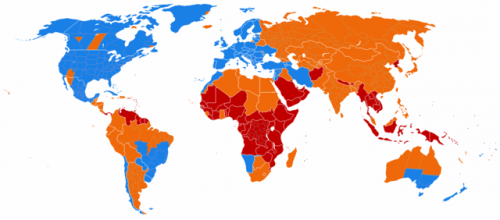I came across this interesting article about Daylight Saving Time (DST) by David Petheric. Firstly, I spent most of my life in countries that were adjusting their times, so I never suspected that there were so many countries, the majority in fact, that didn’t follow this practice. Have a look at the map.
A look at a map of the world today shows very different approaches to DST in different countries, and even within countries such as Canada, Australia and Brazil. Most countries don’t use DST – and most that do are in the northern hemisphere. Blue denotes where DST is observed, Orange where it is no longer observed, and Red where it has never been observed.
Secondly, as David, I also had a question in my head of who did come up with this whole DST thing and who started using it first. The answer is right here.
On the 30th of April 1916, Germany and its World War I allies were the first to use DST as a way to conserve coal during wartime. Britain, most of its allies, and many European neutrals soon followed suit. Russia and a few other countries waited until the next year, and the United States adopted it in 1918. Modern DST was first proposed in 1895 by the New Zealand entomologist George Vernon Hudson, whose shift-work job gave him leisure time to collect insects, and led him to value after-hours daylight. Britain also used double DST during World War II, apparently to ensure there was more daylight time to get the harvest in during the summer.
And thirdly, there is an excellent historical reference for a variable length of the hour:
However, what I found the most fascinating was to discover how ancient civilisation dealt with this issue: temporal hours. They just made the length of an hour flexible. How long an hour lasted depended on what the date was. Flexi time! Babylonian water clocks, which measured time by weight of water, would have around one-sixth of a pound of water added every two weeks after the summer solstice.
Roman water clocks had different scales for different months of the year: at Rome’s latitude the third hour from sunrise, hora tertia, started by modern standards at 09:02 solar time and lasted 44 minutes at the winter solstice, but at the summer solstice it started at 06:58 and lasted 75 minutes. Unequal hours are still used today in a few traditional settings, such as in some Mount Athos monasteries and in Jewish ceremonies.
